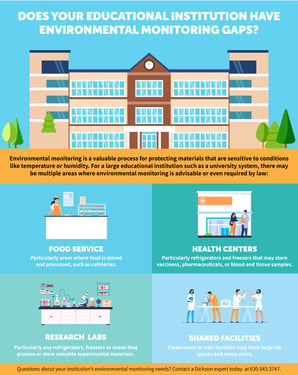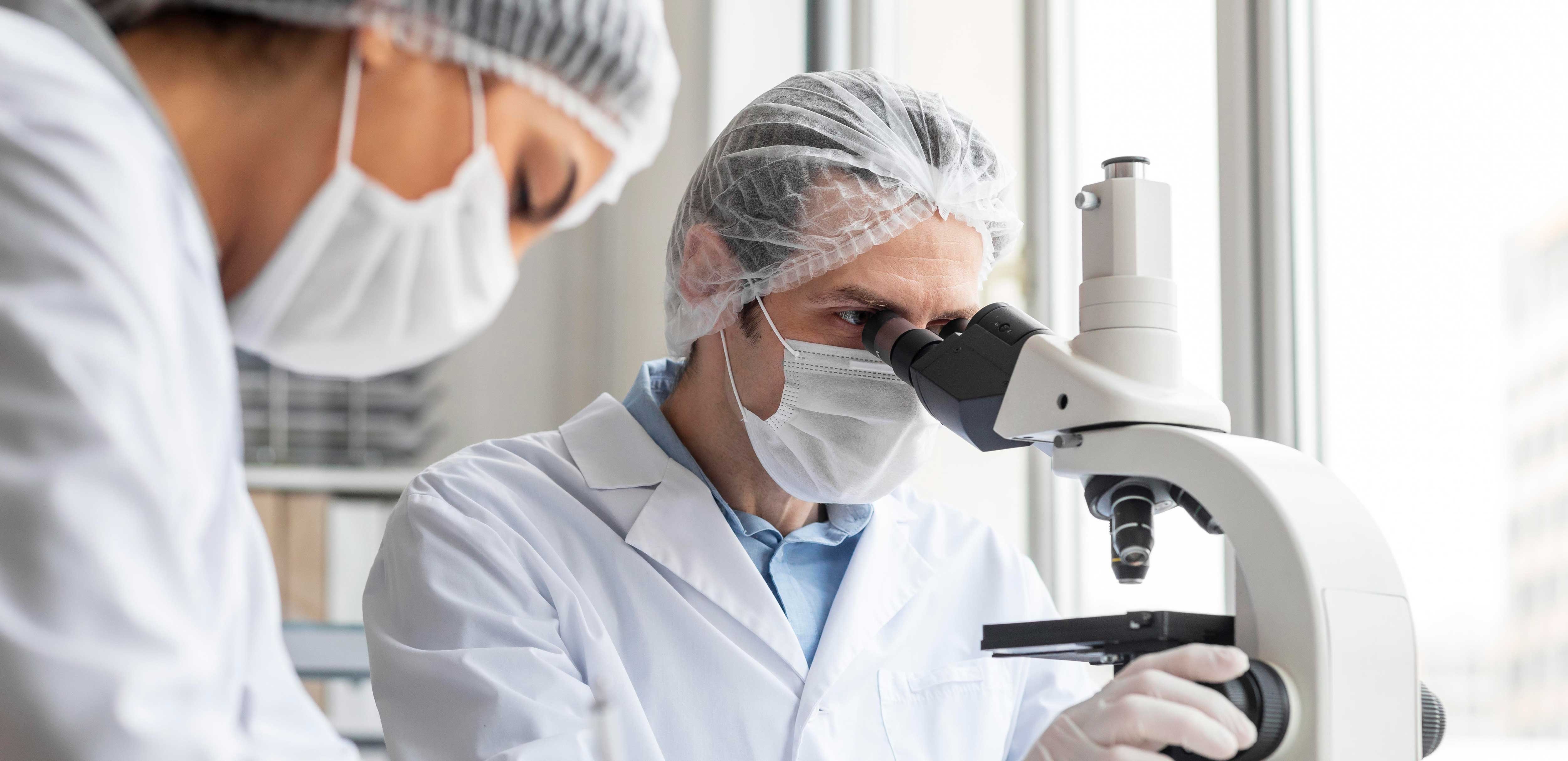Environmental monitoring is an important tool to protect materials that are sensitive to changes in temperature or humidity. Examples include pharmaceuticals, perishable foods, and some specialty chemicals. A good monitoring system provides a precise, complete record of environmental conditions in the places where these materials are stored, like refrigerators, freezers, and warehouses. In addition, modern systems have features that allow proactive responses to problems, such as the ability to view environmental data remotely in real time, or to send customized alarms.

Large educational institutions, like school districts or university systems, may have a number of departments or areas where environmental monitoring would be highly beneficial, or where it is even required by law.
In this article, we’ll discuss the benefits of an organized, systematic, and integrated approach to environmental monitoring for educational systems. We’ll also cover some of the best practices for implementing and running a monitoring network, based on the processes that are used in demanding industrial and transportation settings.
What Do We Mean By Environmental Monitoring?
Most environmental control equipment, like HVAC systems or refrigerators, use thermostats to modulate heating and cooling. However, relying on the control equipment alone to maintain and monitor environmental conditions is extremely risky. Instead, separate environmental monitors should be used to provide a precise record of temperature over time, and to alert staff of equipment issues like power outages, equipment malfunctions, or mistakes on the part of equipment operators. The environmental monitoring system should be considered an independent part of the environmental control system that acts as a safeguard against asset loss and risk to human health.
The environmental conditions we are referring to include temperature, humidity, and differential pressure (negative and positive pressure environments in hospitals and cleanrooms). A basic monitoring system will collect measurements of these conditions, and record them for later review. It could also be set up to trigger alarms when conditions go outside of a pre-set range. An example of this type of monitoring system is a paper chart recorder set up in an area with sensitive materials, like a library archives.
More sophisticated, modern systems provide additional features that improve ease of use and leverage monitoring capabilities to improve asset protection. For example, a network of digital, remote monitoring sensors (digital data loggers or DDLs) can wirelessly upload data to a cloud-based software tool, providing real-time environmental data across the whole system. This data can be accessed from anywhere, quickly processed and visualized, and organized and archived for later analysis or review by auditors. These types of systems also have the capability to send out customized alerts, which we’ll talk more about later in this article.
Remote, cloud-based environmental monitoring systems are also inherently scalable. When a new monitoring point comes on line, like a freezer or an R&D lab, it can be seamlessly integrated into the existing set of monitoring points. This scalability can be a significant cost benefit to educational institutions that are planning to grow or change their research capabilities, or to standardize environmental monitoring across different departments.
Some larger institutions could have operations in areas where environmental monitoring is actually regulated by law. Regulation generally comes into play in cases where poor environmental control can endanger health, for example in storage areas for food or medical supplies.
In food storage and distribution, regulation enforcement is shared between federal, state, and local agencies. For monitoring the safety of drugs and vaccines, the FDA conducts audits to verify compliance with various parts of 21 CFR. These laws, among many other requirements, refer to “appropriate manual, electromechanical, or electronic temperature and humidity recording equipment, devices, and/or logs” for prescription drug storage.
Importantly for universities, the FDA may also conduct inspections of research labs that are involved in early-stage (nonclinical) development of drugs and vaccines as part of the approval process. In this case, it can be beneficial for research labs to comply with Good Laboratory Practices (GLPs) to ensure alignment with FDA requirements. A GLP system will include robust and validated environmental monitoring. Also, FDA notwithstanding, research labs still may be working with invaluable samples for which a loss from a temperature excursion could be catastrophic.
For clinical labs, the monitoring and data collection requirements are regulated much more strictly, making a thorough and well-documented environmental monitoring plan even more critical.
In these highly regulated areas, the consequences of not maintaining adequate environmental monitoring can include public citations, corrective actions, or fines. Specifically for labs involved in drug development, this could lead to disqualification of study data and loss of research funding in the future. More broadly, human safety and consumer trust can be affected if perishable foods or drugs are not properly stored. For example, the CDC recommends vaccines that are inadvertently administered after improper storage should be re-administered. If they can’t be, patients who are given inactive vaccines may incorrectly believe they have immunity, possibly leading to outbreaks.
The proactive features of modern environmental monitoring systems can be used to proactively mitigate and avoid these issues, and to simplify regulatory compliance using automated, accurate record keeping. With regard to data collection, the FDA uses the ALCOA rule: Attributable, Legible, Contemporaneous, Original, and Accurate, which all of which are features of data collected using a cloud-based remote monitoring system.
Areas Where Educational Institutions Benefit from Environmental Monitoring
Specific areas where environmental monitoring could be useful for an educational institution are:
- Food service, specifically in areas where food is stored and processed, as part of an HACCP plan where appropriate. .
- Health centers, for monitoring temperature of refrigerators and freezers used to store pharmaceuticals, or blood products, or tissue samples, or in settings where negative or positive differential pressure is used to provide isolation against infectious diseases.
- Research labs, where refrigerators, ovens, and freezers are used to process and store experimental materials. Ultra-low temperature freezers are particularly important locations for monitoring, since they are used for long-term storage of valuable samples that could take significant time and resources to reproduce in the event of a failure.
- Shared facilities, like cleanrooms, user facilities, and other capital-intensive centers. These facilities may incorporate large lab spaces that require constant control over temperature, humidity, and differential pressure to ensure a clean, consistent operating environment for sensitive R&D. One challenge in these settings is that they have many users, with different levels of training and experience. A robust monitoring system can help to prevent problems caused by operator error.
 Vaccines require special consideration for environmental monitoring. Most vaccines are temperature sensitive, and must be stored from 2 to 8 °C or -50 to -15 °C, or at even lower temperatures for some COVID-19 vaccines. Vaccine doses that experience temperatures outside their specified window can lose potency, in ways that are not visually apparent. For this reason, the CDC recommends using DDLs for vaccine storage monitoring. Vaccines distributed under the Vaccines for Children (VFC) program are more stringently regulated, and require the use of continuous digital data logging at 30 min intervals. This is a critical area, and the CDC publishes detailed storage guidance for sites that administer vaccines.
Vaccines require special consideration for environmental monitoring. Most vaccines are temperature sensitive, and must be stored from 2 to 8 °C or -50 to -15 °C, or at even lower temperatures for some COVID-19 vaccines. Vaccine doses that experience temperatures outside their specified window can lose potency, in ways that are not visually apparent. For this reason, the CDC recommends using DDLs for vaccine storage monitoring. Vaccines distributed under the Vaccines for Children (VFC) program are more stringently regulated, and require the use of continuous digital data logging at 30 min intervals. This is a critical area, and the CDC publishes detailed storage guidance for sites that administer vaccines.
Frequent reviews of monitoring data in this case can help to proactively diagnose equipment issues before they result in loss of cooling. The CDC, for example, recommends weekly reviews of temperature data in vaccine storage areas.
Consider a power outage that affects a lab freezer in the middle of the night. A well-designed monitoring system will alert the responsible personnel immediately, allowing them to take steps to preserve any sensitive material.
Consider, for example, a curing oven in a shared facility. Analysis of monitoring data from the oven could alert staff of possible issues with its operation, like frequent, improper door openings, unauthorized users changing the oven temperature, and other issues that could affect materials being processed by other users.
Determining Your Organization’s Monitoring Needs
Some of the best known methods for the use of environmental monitoring in challenging industrial settings can be applied to educational institutions also. While educational institutions generally have a more diverse set of needs, some of the same principles apply. These include:
- Assembling a committee with single point of contact representatives for stakeholders in each area that would be affected by environmental monitoring
- Ideally, the team would be cross-functional, with a diversity of expertise
- Take the time to ensure that the stakeholder representatives are aligned on needs and areas of concern, and specific goals of a monitoring system. While large institutions can be highly siloed, operating as self-contained departments, there may be cost and efficiency advantages to high-level standardization of environmental monitoring.
- Use a risk-based approach to prioritize monitoring needs. In other words, assess the risk of environmental control issues in each area, and allocate resources to areas with more risk.
- Once the areas of highest risk have been identified, evaluate their specific monitoring needs. For large storage areas, or in cases of highly sensitive or valuable materials (cold rooms, temperature-controlled warehouses, storage freezers), consider a thermal mapping exercise to diagnose temperature fluctuations, over time or spatially. This information can then be used to optimize sensor placement.
- Consider engaging a third-party monitoring expert for help with planning. This has the potential to save costs and speed up implementation.
Selecting the Right Tools for Your Environmental Monitoring
After the needs of the organization are understood and agreed on, the next step is to select the monitoring system. There are many configurations and sensor types available. For example, a lab that stores temperature-sensitive chemicals in a refrigerator might use a single sensor that is read and recorded manually.
For large, multifaceted institutions, and institutions with dynamic or growing monitoring needs, a remote, cloud-based system such as DicksonOne may be a good fit. As we discussed above, these systems can be used to monitor vast networks of wireless sensor points in real time, and are the gold standard for asset protection and efficiency. One major advantage to this type of system is the automation they provide in terms of data collection, archiving, and analysis. Automating these procedures (some of which are regulated by the FDA and other authorities) frees up researchers and other staff to focus on higher level tasks.
In this context, remote monitoring systems contribute to asset protection in two ways. First, thorough review of system-wide monitoring data can help to detect patterns that indicate when control system problems are imminent. Second, they provide the ability to customize alerts, sending messages to personnel via phone, SMS text, or email to targeted groups of people, within moments of detecting a problem. For example, an alert of loss of temperature control can be sent directly to local support staff, allowing them to respond quickly. The alert messages themselves can also be customized, so that the response team is prepared on arrival.
The importance of continuous, real-time and remote access to monitoring data has been highlighted by the COVID-19 crisis. Partial shutdowns, where institutions reduce staffing levels, mean that there are fewer staff present to directly monitor environmental control systems. The automation provided by a remote cloud-based system means that the on-site staff can focus on the critical tasks at hand, and that temperature control issues don’t go undetected due to infrequent or missed in-person checks of storage location conditions.
Executing and Maintaining Your Environmental Monitoring Processes
This is another area where we can look to the practices used in highly regulated industries, and adapt this principles and frameworks for educational institutions.
- Confirm and document that the monitoring system satisfies its intended purpose, a process called “validation”. That is useful in this context, since it encourages the implementation team to deliberately agree on the intended purpose, and use it as a focus while selecting and implementing the system.
- Confirm that the monitoring equipment is delivered, installed, and configured correctly (“installation qualification”)
- Ensure that sensors are calibrated when delivered, and have a plan for regularly calibrating sensors. A remote monitoring system can help with this, by tracking the calibration status of sensors system-wide.
- Consider establishing a relationship with an environmental monitoring vendor. The right vendor can provide support during the design and installation phases, as well as helping you to scale and modify your system as your institution grows and evolves.
Conclusion
To summarize the key points in this article:
- Environmental monitoring is a powerful tool for safeguarding sensitive assets, protecting human health, and improving productivity in several areas relevant to large educational institutions
- In some of these areas, environmental monitoring is regulated by law
- A remote, cloud-based monitoring system, implemented across departments where possible, is a good option for large institutions to improve efficiency and scalability
- Some of the monitoring practices used in highly regulated industrial settings can be adapted for educational institutions
Finally, for implementing and maintaining environmental monitoring in large, complex institutions, engaging with a vendor with expertise in this area can save significant time and cost. Any educational organization with questions about environmental monitoring is encouraged to contact the experts at Dickson.




